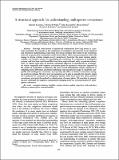Por favor, use este identificador para citar o enlazar a este item:
http://hdl.handle.net/10261/160981COMPARTIR / EXPORTAR:
 SHARE SHARE
 CORE
BASE CORE
BASE
|
|
| Visualizar otros formatos: MARC | Dublin Core | RDF | ORE | MODS | METS | DIDL | DATACITE | |

| Campo DC | Valor | Lengua/Idioma |
|---|---|---|
| dc.contributor.author | Saavedra, Serguei | es_ES |
| dc.contributor.author | Rohr, Rudolf P. | es_ES |
| dc.contributor.author | Bascompte, Jordi | es_ES |
| dc.contributor.author | Godoy, Óscar | es_ES |
| dc.contributor.author | Kraft, Nathan J. B. | es_ES |
| dc.contributor.author | Levine, J. M. | es_ES |
| dc.date.accessioned | 2018-02-20T09:48:56Z | - |
| dc.date.available | 2018-02-20T09:48:56Z | - |
| dc.date.issued | 2017-08 | - |
| dc.identifier.citation | Ecological Monographs 87(3): 470-486 (2017) | es_ES |
| dc.identifier.citation | "Copyright by the Ecological Society of America" | - |
| dc.identifier.issn | 0012-9615 | - |
| dc.identifier.uri | http://hdl.handle.net/10261/160981 | - |
| dc.description | 17 páginas.-- 9 figuras.-- 55 referencias.-- Additional supporting information may be found online at: http://onlinelibrary.wiley.com/doi/10.1002/ecm.1263/full486 SERGUEI SAAVEDRA ET AL. Ecological Monographs Vol. 87, No. 3 .-- "Copyright by the Ecological Society of America" | es_ES |
| dc.description.abstract | Although observations of species-rich communities have long served as a primary motivation for research on the coexistence of competitors, the majority of our empirical and theoretical understanding comes from two-species systems. How much of the coexistence observed in species-rich communities results from indirect effects among competitors that only emerge in diverse systems remains poorly understood. Resolving this issue requires simple, scalable, and intuitive metrics for quantifying the conditions for coexistence in multispecies systems, and how these conditions differ from those expected based solely on pairwise interactions. To achieve these aims, we develop a structural approach for studying the set of parameter values compatible with n-species coexistence given the geometric constraints imposed by the matrix of competition coefficients. We derive novel mathematical metrics analogous to stabilizing niche differences and fitness differences that measure the range of conditions compatible with multispecies coexistence, incorporating the effects of indirect interactions emerging in diverse systems. We show how our measures can be used to quantify the extent to which the conditions for coexistence in multispecies systems differ from those that allow pairwise coexistence, and apply the method to a field system of annual plants. We conclude by presenting new challenges and empirical opportunities emerging from our structural metrics of multispecies coexistence. | es_ES |
| dc.description.sponsorship | We thank the Plant Ecology Group at ETH Zurich for stimulating discussions that improved this manuscript, and Jacob Usinowicz for valuable comments on the paper. Funding was provided by the 2016 MIT Research Committee Funds (S. Saavedra), the European Research Council through an Advanced Grant (J. Bascompte), NSF 1644641 (N. J. B. Kraft and J. M. Levine), ETH Zurich (J. M. Levine), and postdoctoral financial support provided by the Spanish Ministry of Economy and Competitiveness JCI-2012-12061 (O. Godoy). The authors declare no competing financial interests. S. Saavedra and R. P. Rohr performed the study and contributed equally to the work. S Saavedra, R. P. Rohr, J. Bascompte, and J. M. Levine contributed to the design of the study; O. Godoy, N. J. B. Kraft, and J. M. Levine provided the empirical data; S. Saavedra, R. P. Rohr, and J. M. Levine wrote the first draft of the manuscript; all authors contributed to revisions. | es_ES |
| dc.language.iso | eng | es_ES |
| dc.publisher | Ecological Society of America | es_ES |
| dc.publisher | John Wiley & Sons | es_ES |
| dc.relation.isversionof | Publisher's version | es_ES |
| dc.rights | openAccess | es_ES |
| dc.subject | Community dynamics | es_ES |
| dc.subject | Feasibility | es_ES |
| dc.subject | Invasion criterion | es_ES |
| dc.subject | Multiple competitors | es_ES |
| dc.subject | Niche and fitnessdifferences | es_ES |
| dc.subject | Pairwise effects | es_ES |
| dc.subject | Structural stability. | es_ES |
| dc.title | A structural approach for understanding multispecies coexistence | es_ES |
| dc.type | artículo | es_ES |
| dc.identifier.doi | 10.1002/ecm.1263 | - |
| dc.description.peerreviewed | Peer reviewed | es_ES |
| dc.relation.publisherversion | http://dx.doi.org/10.1002/ecm.1263 | es_ES |
| dc.contributor.funder | Ministerio de Economía y Competitividad (España) | es_ES |
| dc.relation.csic | Sí | es_ES |
| oprm.item.hasRevision | no ko 0 false | * |
| dc.identifier.funder | http://dx.doi.org/10.13039/501100003329 | es_ES |
| dc.type.coar | http://purl.org/coar/resource_type/c_6501 | es_ES |
| item.openairetype | artículo | - |
| item.languageiso639-1 | en | - |
| item.fulltext | With Fulltext | - |
| item.grantfulltext | open | - |
| item.cerifentitytype | Publications | - |
| item.openairecristype | http://purl.org/coar/resource_type/c_18cf | - |
| Aparece en las colecciones: | (IRNAS) Artículos (EBD) Artículos | |
Ficheros en este ítem:
| Fichero | Descripción | Tamaño | Formato | |
|---|---|---|---|---|
| A_structural_ approach_understanding_2017.pdf | 1,3 MB | Adobe PDF |  Visualizar/Abrir |
CORE Recommender
SCOPUSTM
Citations
149
checked on 03-may-2024
WEB OF SCIENCETM
Citations
139
checked on 18-feb-2024
Page view(s)
347
checked on 08-may-2024
Download(s)
237
checked on 08-may-2024
Google ScholarTM
Check
Altmetric
Altmetric
NOTA: Los ítems de Digital.CSIC están protegidos por copyright, con todos los derechos reservados, a menos que se indique lo contrario.
